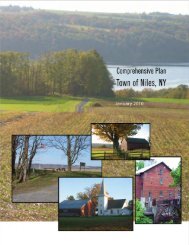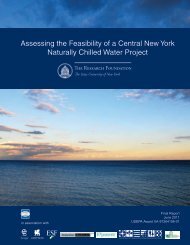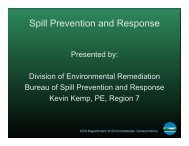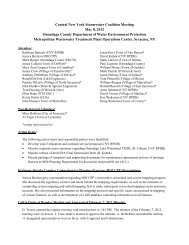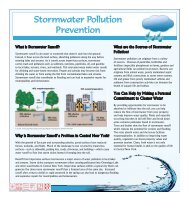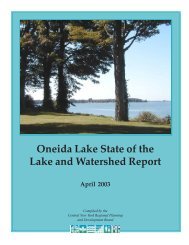A Management Strategy for Oneida Lake and its ... - CNY RPDB Home
A Management Strategy for Oneida Lake and its ... - CNY RPDB Home
A Management Strategy for Oneida Lake and its ... - CNY RPDB Home
You also want an ePaper? Increase the reach of your titles
YUMPU automatically turns print PDFs into web optimized ePapers that Google loves.
Encouraging Safe Road Deicing Application <strong>and</strong> Storage<br />
Program Goal<br />
Minimize negative environmental impacts of road deicers<br />
on water resources in the <strong>Oneida</strong> <strong>Lake</strong> watershed<br />
page 80<br />
Problem Identification<br />
Snow <strong>and</strong> ice on winter roads in the <strong>Oneida</strong><br />
<strong>Lake</strong> watershed is a public safety issue. To<br />
remove this danger <strong>for</strong> drivers, municipalities<br />
rely on road salt (NaCl) because it is costeffective<br />
($30/ton) <strong>and</strong> efficient.<br />
National research has shown that road salt can<br />
have negative environmental impacts on<br />
waterways. However, groundwater contamination<br />
<strong>and</strong> negative impacts on fish <strong>and</strong> wildlife<br />
have not been determined in the <strong>Oneida</strong> <strong>Lake</strong><br />
watershed.<br />
Transportation agencies may be asked in the<br />
future to use more environmentally friendly<br />
alternatives to road salt but few guidelines<br />
currently exist to determine which alternative<br />
products are effective, economical, <strong>and</strong> nondetrimental<br />
to the environment.<br />
Alternative products <strong>for</strong> road de-icing such as<br />
urea, potassium acetate, magnesium chloride,<br />
calcium chloride, have not been extensively<br />
studied to determine the environmental<br />
impacts. In addition, many of these products<br />
are very expensive ($500/ton in some cases<br />
vs. $30/ton <strong>for</strong> road salt) <strong>and</strong> are not as<br />
efficient as road salt.<br />
Urea, which is commonly used around bridges<br />
to decrease corrosion, may increase nutrient<br />
loading to waterways. The use of abrasives,<br />
such as s<strong>and</strong>, also increases cleanup <strong>and</strong> road<br />
maintenance costs <strong>for</strong> Highway Departments<br />
<strong>and</strong> negatively impact storm sewers.<br />
A comprehensive tributary monitoring study<br />
was conducted on all of the major streams<br />
flowing into <strong>Oneida</strong> <strong>Lake</strong> during 2002 –2003.<br />
Of the eleven subwatersheds studied, four<br />
were found to contribute the largest amount of<br />
chloride, a component of de-icing salt, to<br />
downstream habitats during storm events.<br />
These include Butternut Creek (2,554<br />
g/ha/day) Chittenango Creek (2,467 g/ha/day),<br />
Limestone (1,875 g/ha/day), <strong>and</strong> Big Bay<br />
(1,800 g/ha/day).<br />
Impacts<br />
NaCl is the most commonly used road deicer<br />
in the nation. According to the National<br />
Research Council, road salt use in the United<br />
States ranges from 8 million –12 million tons<br />
per year. New York’s annual road salt usage<br />
is 500,000 tons/yr. More recently, the use of<br />
NaCl has come under the scrutiny of environmental<br />
regulators because of <strong>its</strong> long-term<br />
impacts on the aquatic environment <strong>and</strong><br />
potential implications to people that rely on<br />
groundwater resources <strong>for</strong> drinking water.<br />
Despite negative public perception, the<br />
influence on fish <strong>and</strong> wildlife, well contamination,<br />
<strong>and</strong> other potentially harmful impacts of<br />
road deicers in the <strong>Oneida</strong> <strong>Lake</strong> watershed<br />
have not been scientifically researched or<br />
<strong>for</strong>mally documented as a significant problem.<br />
Research conducted by the University of<br />
Toronto, however, found that in metropolitan<br />
Toronto, 45% of the salt applied to roads runs<br />
off in the first flush <strong>and</strong> the remaining 55%<br />
seeps into groundwater. Most of this salt<br />
reemerges in local streams within a 50 year<br />
time span, increasing salt concentrations in<br />
Chapter 3: Priority Areas



